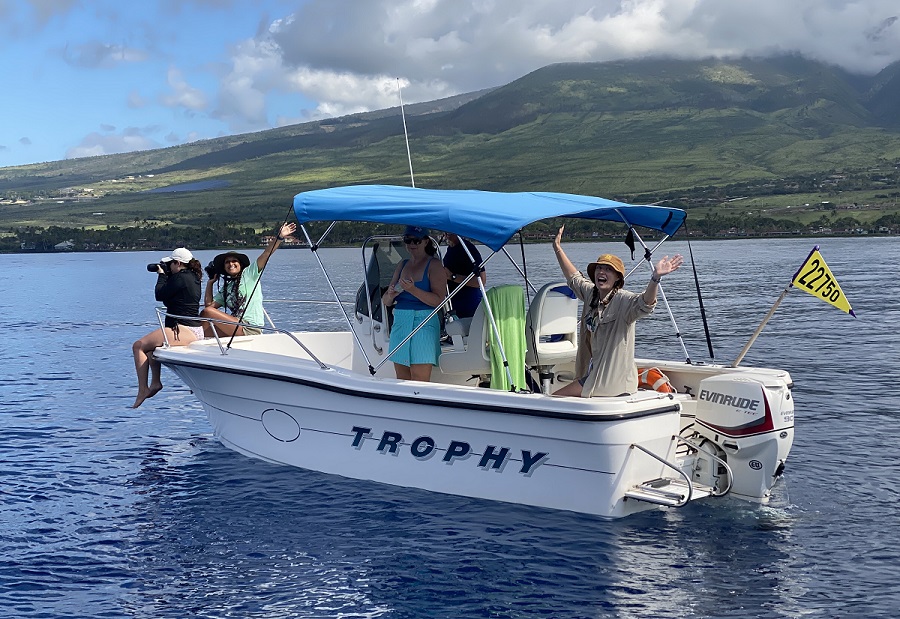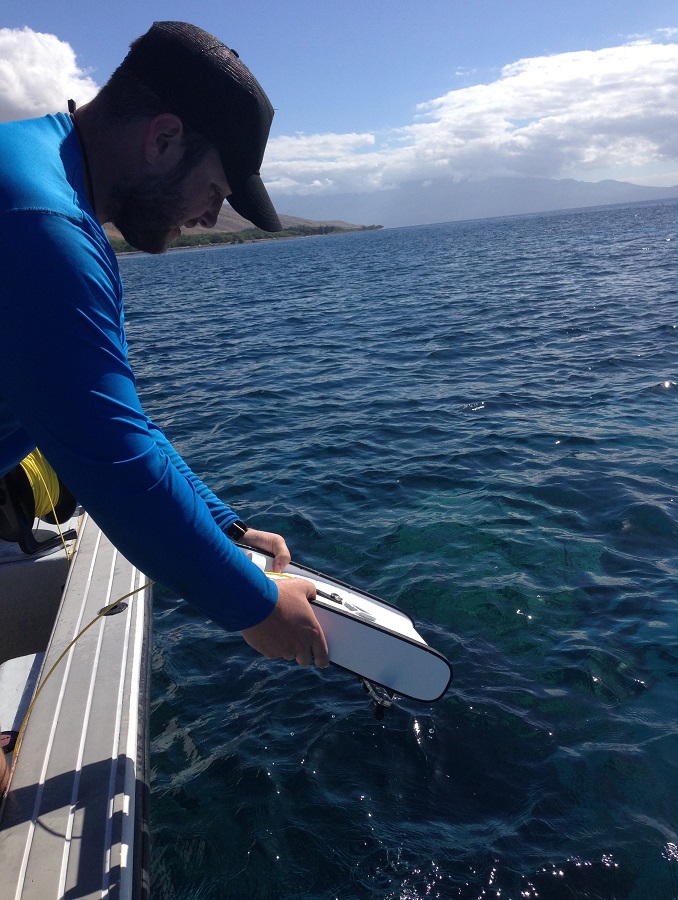CAMARILLO — The historic Hawaiian village of Lahaina has been integral to CSU Channel Islands (CSUCI) student and faculty research for years. Lahaina has been the base for CSUCI student research led by Professor Emerita and whale biologist Rachel Cartwright, Professor of Mathematics Cindy Wyels, and Associate Professor of Environmental Science & Research Management (ESRM) Clare Steele.
 Lahaina is now four months into what will be years of cleanup and restoration following the fires that tore through Maui in early August, causing billions of dollars’ worth of damage, destroying 3,000 structures, and reducing the historic town of Lahaina to smoldering ruins. Several of CSUCI’s non-governmental organizations (NGO) partners lost their homes.
Lahaina is now four months into what will be years of cleanup and restoration following the fires that tore through Maui in early August, causing billions of dollars’ worth of damage, destroying 3,000 structures, and reducing the historic town of Lahaina to smoldering ruins. Several of CSUCI’s non-governmental organizations (NGO) partners lost their homes.
So, Wyels, Cartwright and Steele decided to offer students a chance to use their skills to help rebuild Lahaina with a service-learning trip scheduled for Jan. 10-20, 2024.
“We’re going because we have a long history with Lahaina,” Wyels said. “I think you can’t just parachute in after the disaster, but we have data going back years. We also have necessary skills. During the Thomas fire, our students used drones to map previously overgrown archaeological sites, for example. And this is super relative to the climate change research we’ve been doing, too.”
 Professor of ESRM Sean Anderson will also go along on the trip as he has a wealth of experience from student research and restoration trips he led to New Orleans following the devastation of Hurricane Katrina, as well as personal ties to the area.
Professor of ESRM Sean Anderson will also go along on the trip as he has a wealth of experience from student research and restoration trips he led to New Orleans following the devastation of Hurricane Katrina, as well as personal ties to the area.
“I have family from Hawaii, and when I was a kid, my dad would spend time in Lahaina selling art,” Anderson said. “The boat we use for whale research trips was based out of the Lahaina fuel dock a block from where I worked art shows in the 1970s.”
Twenty students will help with restoration, cleanup and anything else that needs to be done while also conducting research on how the fire affected the environment and sea life. ESRM lab technician Zach Adkins will go along as well as Associate Professor of English Stacey Anderson.
“There will be three teams of student researchers that will rotate,” Anderson said. “One team will be on a boat doing whale research. We will have our well-trained student pilots deploy drones when we encounter mother-calf humpback whale pods. We can get some good photos from a distance, but straight down imagery directly over them tells us about the health and body condition of these whales.”
The second team will be doing terrestrial fire impact monitoring, checking water quality to see what sort of erosion has occurred. All of this work is familiar to Anderson, who has been leading students with restoration and research efforts in New Orleans ever since Hurricane Katrina in 2005.
“The third team will be lending their backs for anything local NGOs need. It could be demolition or replanting, it could be babysitting and handing out water,” Anderson said.
Anderson and Steele are developing a class for the spring semester called “Disaster Recovery and Environmental Modeling” and plan to integrate the 20 students who visit Lahaina into the classes. This will be the fifth time Wyels has been a faculty lead on the whale research trips and she will be involved in data collection and analysis from the research findings.
Along with skills they have picked up at CSUCI, many of the 20 students headed to Lahaina have personal ties to Maui and its heart, Lahaina.
ESRM major Jadynn Rosenberger has a family friend who lives in Maui, having retired from the U.S. Navy with enough money saved up to purchase a condominium.
“When the fire first happened, she lost her new condominium,” Rosenberger said. “She also didn’t have a car, so when she evacuated, all she had was a backpack and the clothes she was wearing. I’m hoping to reach out to her when I’m over there.”
ESRM major Dylan Scobey’s family visited Lahaina every two years, so it held a deep place in his heart, he said.
“Wandering along Front Street, indulging in shaved ice, exploring the art shops and savoring the mesmerizing sunsets over the harbor,” Scobey said. “Having grown up in California, I’ve become accustomed to natural disasters affecting my region, but witnessing a fire ravage this historical town that I hold so dear had a profound impact on me.”
Scobey said he is eager to contribute to a community that has given him countless cherished memories and a chance to gain a new perspective on local culture.
After he graduates, Scobey plans a future in island conservation, so he believes this experience will help him lay a foundation for a career in the field.
ESRM major Willow Jackson’s desire to help the island rebuild comes from her own experience as the member of an indigenous Alaskan village.
“I grew up on a small, rural, indigenous-populated island called Kake, which is located in Southeast Alaska,” Jackson wrote in an essay to apply to go on the trip. “There, my people are extremely reliant on the ocean and the land for our way of life, as groceries are very expensive there due to barge shipments. Over the last few years of living there, I noticed a severe decline in the amount of subsistence foods that my people were harvesting, and climate change is to blame for that. Hence, the reason why I’m an ESRM major is so I can work to help coastal communities similar to the one I come from.”
Funds for the trip come from different sources, including $50,000 from CSUCI’s Instructionally Related Activities (IRA) with an additional $15,000 from the Maxwell/Hanrahan Foundation, but the public is welcome to donate to the students’ efforts to rebuild Lahaina and parts of Maui by visiting: ?https://esrm.csuci.edu/givetoesrm.htm
CALIFORNIA STATE UNIVERSITY CHANNEL ISLANDS — California State University Channel Islands (CSUCI) is Ventura County’s only public university and opened in 2002 as the 23rd campus in the CSU system serving the regions of Ventura, Santa Barbara, and Los Angeles counties, as well as the entire state. CSUCI is located between Camarillo and the Oxnard Plain, midway between Santa Barbara and Los Angeles and 25 miles north from Malibu.
The campus is nestled against the foothills of the Santa Monica Mountains and is a 10-minute drive from the Pacific Ocean. With more than 5,600 students, 24,500 alumni, and 1,000 employees, CSUCI is poised to grow in size and distinction, while maintaining one of the most student-focused learning environments in public higher education with more than 90 academic degrees, teaching credentials, certificates, and professional and community programs.
Connect with and learn more by visiting www.csuci.edu or CSUCI’s Social Media.
The University encourages persons with disabilities to participate in its programs, events and activities. If you anticipate needing any type of accommodation, or have questions about the physical access provided, please contact the respective area below as soon as possible, but no later than seven (7) business days prior to the event/activity:
CSUCI Students: accommodations@csuci.edu
CSUCI Employee and members of the public: angela.portillo@csuci.edu

